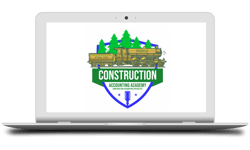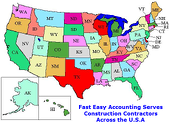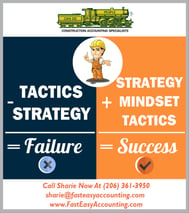
USP, MAP, OPM
Develop your Unique Selling Proposition - the one thing you do better than anyone else in your Geographic and Psychographics Target Market. Try selling your contracting services to a potential customer. Going through this process will help you refine your Value Proposition.
Develop your systems using MAP, not PAM (Marketing first, Accounting second, and Production last), so you can be prepared for the bumps in the road that can (and will most likely) occur. Always remember The Five Ps: Prior Preparation Prevents Poor Performance.
Use OPM (Other People's Money) by getting job deposits and regular progress payments. Stop borrowing money at 18% and lending it at 0%.
Identify your USPs
USPs can come in many shapes and sizes. Here are some common examples:
- Unique product features/services
- Convenient locations
- Expert knowledge
- Superior service
- Superior quality
- Faster turnaround times
- Better payment options
- Better price
- Solid and unique branding
Make USPs central to your construction business planning
If you're still in the stage of planning a new trade business, you have the opportunity now to make USPs central to your business concept. You can build USPs around your company's strengths later on, but USPs can be much more effective if the business is planned and developed around them.
Research the market, look at your competitors' propositions to your target market and see where you could improve. Sometimes, a construction company's most vital USP is simply a brand the target market identifies with more than others. For example, if your niche is luxury bathroom remodeling - use only the best materials and high-end furnishings; if clients are willing to pay for your top-notch service and extravagant work along with the expensive, quality, and branded products, you build on it and stay in your lane.
It all depends on your target market's needs and how established competitors are already catering to them.
If you have trouble identifying possible USPs for your start-up, make sure you:
- Talk to the target market.
- Assess existing solutions in the marketplace and the strength of your established competitors' USPs.
- Write a short executive summary for your business plan to help zero in on your USPs.
Research your competitors' USPs
Whether you're still in the pre-start-up phase or already in business, you won't be able to develop accurately targeted USPs without checking out your competition first.
The key to effective competitor research is to experience what their customers experience.
1. Identify competitors:
Online and business directory research will only take you so far.
Talk directly to the target market to find competitors who generate robust and positive word of mouth without relying on advertising, directory listings, or a solid online presence.
These businesses are harder to find, but if they exist in your market, they could be your most substantial competition.
2. Become a customer:
Once you have a list of your core competitors, visit them, interact with staff as a customer, and - budget permitting - buy a contrasting range of products from them through different sales channels or through a friend or relative looking to hire.
If you only test the customer experience in one way, you won't completely understand your competitor's strengths and weaknesses.
After you've sampled their offering, talk to their customers and suppliers to gather opinions that could support or challenge what you found in person. If you find the perception of the business is better or worse than the experience, take note and incorporate this into your assessment.
If your competitors will recognize you, ask a friend to gather information for you or consider hiring a professional mystery shopper.
3. Compare and analyze:
Assign USPs to each of your competitors and compare them with your own. After you rate the USPs on their potency with the target market, group them.
If you find that some or most of your competitors share the same USPs, pick others to help your business stand out.
Market your USPs effectively.
Developing USPs is only half the battle. The other is communicating them to your customers.
Try marketing your USPs by:
Encouraging positive word of mouth:
Word-of-mouth marketing can be highly cost-effective and robust if carried out consistently. You must ensure your business delivers above and beyond the call of duty - within reason, of course - to your target market and incentivize your customers to recommend your company to others.
As your database grows, you keep communicating with e-newsletters and special 'member-only' offers to help further spread the word.
If you focus on delivering your USPs in person and marketing them to your growing community via your database, you may never need to advertise again.
Training staff to deliver consistent messages:
Consistency is critical to delivering any message. Train your staff to emphasize your USPs while interacting with customers in the same consistent manner, and test them regularly to ensure the message is being delivered in the way you require.
Match this with consistent branding, and it'll be difficult for anyone not to get the message.
Designing consistent branding:
Your brand should communicate your USPs in one word or phrase. Make it simple, easy, and memorable.
Avoid obscure references or in-jokes, and instead, focus on communicating your USPs with crystal clarity and a unique quality that reflects the values of your business.
Once you've developed a brand, ensure it's featured on all your marketing materials - from your shop window to your website, business cards, and vehicles.
If you're already in business but you've identified USPs that don't fit the brand, carry out a complete cost analysis on the long-term financial impact of repositioning your business before you go ahead.
Thinking outside the box:
Think of eye-catching, memorable ways to align your marketing with your USPs. For example, if your quality is superior, can you publicly demonstrate your product or service longevity or offer a prize for customers who reach a particular milestone in usage? The more engaging and original you can make your marketing, the better.
While developing a marketing message to communicate your USPs, consider developing arguments that answer or minimize the effects of your competitors' USPs.
Customers will come to you with common queries comparing your offerings with your competitors, so it's worth developing consistent and thoughtful answers beforehand rather than thinking on the spot.
Final thoughts
What your construction business does, whom it serves, why it differs from other companies, and how it benefits your prospective client contribute to your overall branding and client acquisition.
About The Author:
![]() Sharie DeHart, QPA, is the co-founder of Business Consulting And Accounting in Lynnwood, Washington. She is the leading expert in managing outsourced construction bookkeeping and accounting services companies and cash management accounting for small construction companies across the USA. She encourages Contractors and Construction Company Owners to stay current on their tax obligations and offers insights on managing the remaining cash flow to operate and grow their construction company sales and profits so they can put more money in the bank. Call 1-800-361-1770 or sharie@fasteasyaccounting.com
Sharie DeHart, QPA, is the co-founder of Business Consulting And Accounting in Lynnwood, Washington. She is the leading expert in managing outsourced construction bookkeeping and accounting services companies and cash management accounting for small construction companies across the USA. She encourages Contractors and Construction Company Owners to stay current on their tax obligations and offers insights on managing the remaining cash flow to operate and grow their construction company sales and profits so they can put more money in the bank. Call 1-800-361-1770 or sharie@fasteasyaccounting.com
OUTSOURCED ACCOUNTING FOR
THE BUSY CONTRACTOR
IN A MOBILE ENVIRONMENT
 |
 |
 |
 |
Download the Contractors APP today from the App Store or Android Store
Access Code: FEAHEROS
Click here to download the App on Android:
Click here to download the App on iOS:
Simply scan the QR code or search for ‘MyAccountants’ in the App Store and enter the Access code: FEAHEROS to utilize the powerful App features and capabilities and benefit from having our Construction Accounting App at your fingertips, 24/7."
PS: Even if you are not a Construction Contractor, you will find plenty of benefits in the app, so we invite you to download it too! It's Free so why not?





























